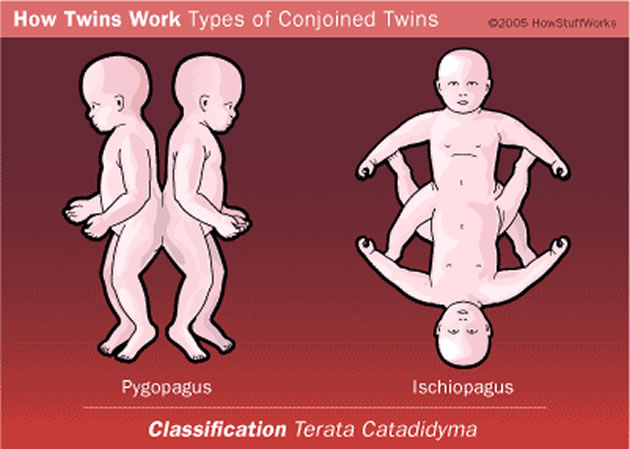Facts about conjoined twins

 BIRTHS of conjoined twins, whose skin and internal organs are fused together, are rare. Conjoined twins occur once in every 200 000 live births, and their survival is anything but assured.
BIRTHS of conjoined twins, whose skin and internal organs are fused together, are rare. Conjoined twins occur once in every 200 000 live births, and their survival is anything but assured.
Approximately 40 to 60 percent of conjoined twins arrive stillborn, and about 35 percent survive only one day.
The overall survival rate of conjoined twins is somewhere between 5 percent and 25 percent.
For some reason, female siblings seem to have a better shot at survival than their male counterparts.
Although more male twins conjoin in the womb than female twins, females are three times as likely as males to be born alive. Approximately 70 percent of all conjoined twins are girls.
How They Are Formed
Conjoined twins are genetically identical, and are, therefore, always the same sex. They develop from the same fertilised egg, and they share the same amniotic cavity and placenta.
Twinning occurs one of two ways: either a woman releases two eggs instead of the usual one or she produces only one egg that divides after fertilisation. If she releases two eggs, which are fertilised by separate sperm, she has fraternal twins. When a single, fertilised egg divides and separates, she has identical or paternal twins.
In the case of conjoined twins, a woman only produces a single egg, which does not fully separate after fertilisation.
The developing embryo starts to split into identical twins during the first few weeks after conception, but stops before the process is complete. The partially separated egg develops into a conjoined fetus.
A History of Conjoined Twins
One of the earliest documented cases of conjoined twins were Mary and Eliza Chulkhurst.
They were born in Biddenden, County of Kent, England in the year 1100, and were joined at the hip.
The wealthy sisters, who were known as the Biddenden Maids, lived for 34 years. When they died, they left a small fortune to the Church of England.
In honour of their generosity, it was customary for English citizens to bake little biscuits and cakes in the sisters’ images and give them to the poor.
Another set of famous conjoined twins was Eng and Chang Bunker, who were born in Thailand (then called Siam) in 1811. The term Siamese twins was coined as a reference to Eng and Chang, who achieved international fame shortly after leaving Siam as teenagers.
They were joined at the lower chest by a narrow band of flesh, which connected their livers. They were exhibited in circus shows around the world before settling in the United States, where they married two sisters and had nearly two dozen children. They were successful businessman and ranchers in Wilkes County, North Carolina, where they lived until 1874. They were 63 years old when they died.
The term Siamese twins is no longer considered appropriate. Conjoined twins aren’t limited to any racial or ethnic group and indeed have been born all over the world.
—Various Types of Conjoined Twins—
There are nearly a dozen different types of conjoined twins. One of the most common classifications is thoracopagus twins. These twins are connected at the upper portion of the torso.
Thoracopagus twins share a heart, which, depending on how closely they are joined, makes it nearly impossible to separate them and save them both. Thoracopagus twins make up about 40 percent of all conjoined cases.
Another common type of conjunction is called omphalopagus, where twins are connected from the breastbone to the waist. About 33 percent of all conjoined cases are categorised as omphalopagus. These twins may share a liver, gastrointestinal or genitourinary functions, but rarely share a heart.
One of the rarest types of conjoined twins is craniophagus twins, which are joined at the cranium or head. In fact, only 2 percent of all conjoined twins are joined in this way.
—Separating Twins: No Easy Matter—
The surgical separation of conjoined twins is a delicate and risky procedure, requiring extreme precision and care. Therefore, the decision to separate twins is a serious one.
Mortality rates for twins who undergo separation vary, depending on their type of connection, and the organs they share. For example, twins joined at the sacrum at the base of the spine have a 68 percent chance of successful separation, whereas, in cases of twins with conjoined hearts at the ventricular (pumping chamber) level, there are no known survivors.
Although success rates have improved over the years, surgical separation is still rare. Since 1950, at least one twin has survived separation about 75 percent of the time.
It is only after twins are born that doctors can use magnetic resonance imaging, ultrasound and angiography to find out what organs the twins share. In order to determine the feasibility of separation, doctors must carefully assess how the twins’ shared organs function.
After separation, most twins need intensive rehabilitation because of the malformation and position of their spines. The muscles in their backs are constantly being flexed and they often have a difficult time bending their backs forward and backwards and sitting up straight.
Source: Conjoined Twins Facts | University of Maryland Medical Center









Comments